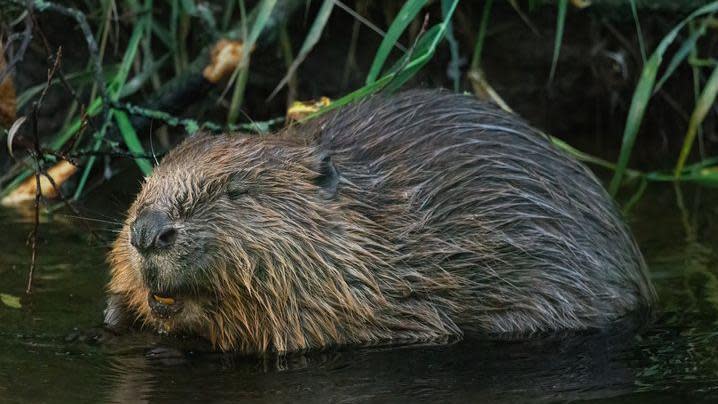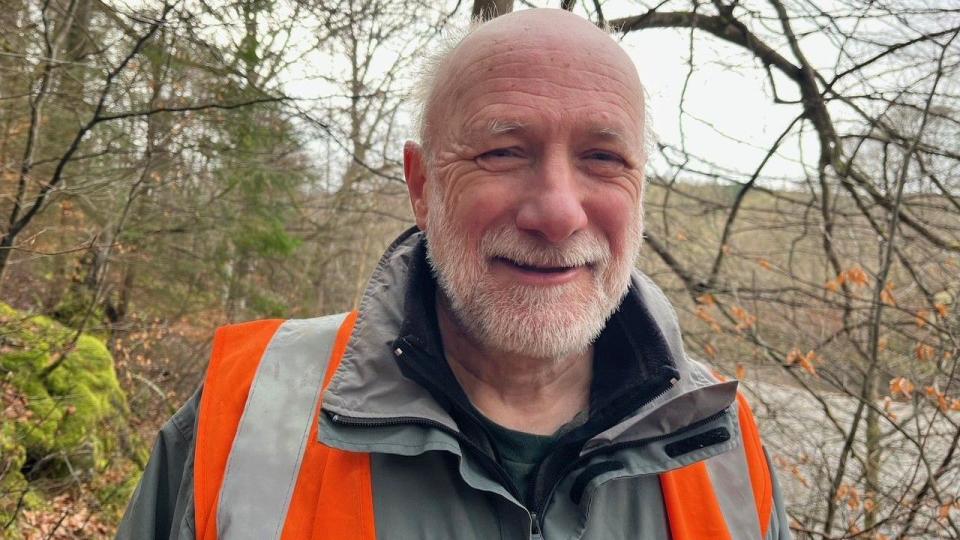'Beavers can bring a tree down in a night'
Armed with spades, rolls of wire fencing and metal pegs, a group of volunteers in a Highland Perthshire town are trying to protect trees from beavers.
Colin Somerville from The Pitlochry Path Group says the beavers will bring a tree down in a night if they get the chance.
The group was set up to repair a large network of well-used tracks in and around the popular tourist town.
But they are now turning their hand to fitting mesh cages around trees after several trees were felled by beavers.

Beavers died out in Scotland about 400 years ago but have been gradually reintroduced since 2009 in different parts of Scotland.
Populations have been established in Tayside, on the Forth, in Knapdale and at Loch Lomond.
The animals, which are primarily nocturnal, build dams made of branches and tree trunks.
Conservation organisations say beaver activity can improve water quality and natural habitats and help to alleviate flooding.
But farmers have concerns saying the work of the mammals leads to flooding and damage to crops.
The Pitlochry Path Group consulted with experts from the charity Beaver Trust who approved their plan to protect two locations - by the River Tummel and beside a small burn next to housing in the town.
Mr Somerville says the charity advised them to protect more mature trees and the ones that are being targeted near housing.
He describes the one-metre high mesh as “almost like a burglar alarm in your house".
He said: "It’s not going to guarantee the burglars are not going to go, but it is trying to move them on somewhere else."
Mr Somerville said the mesh needs to be pegged down otherwise the beavers would be able to lift it out of the way.
The project, which also aims to stop the felled trees from falling onto properties, only started at the beginning of the year but so far it appears to be working.
Recently, Chloe Campbell and her husband Blair were shocked to encounter a beaver walking up a main road in Pitlochry town centre.
The couple reversed their car so as not to run it over, with Chloe saying it was unfazed and started chasing them.

The Pitlochry Path Group was formed in 2013 as concerned local outdoor enthusiasts noted the network of popular walking trails set up by Perth and Kinross Council in 1996 were falling into disrepair.
Secretary Cath Marshall says that although the council were unable to maintain the paths, the group does get some money from them, alongside grant funding and donations.
A growing number of path groups have been set up across Perth and Kinross with many supported by a Greenspace Ranger.
The volunteers who regularly turn out in Pitlochry are involved with projects, small and large, from clearing leaves from drains, removing fallen trees to even upgrading a popular mountain path.
Volunteer Chris Allen is working with a group of volunteers on the path beside the River Garry near Killiecrankie.
He says: “The tree roots are a real big problem and they present really serious trip hazards. The path gets narrower and sloping.”
The roots are quite challenging to get out, Mr Allen says.
He says the technique they use is one that has been used for many years and it is mostly about using common sense although within the group there are civil engineers who can lend their expertise to solve problems.
Although he admits some jobs are too big for the team.
Some members of the group formed the Friends of Ben Vrackie as they were keen to repair the badly eroded path to the popular local mountain but due to the complexity of the project a contractor was hired.
Perth and Kinross Countryside Trust secured more than £200,000 to pay for the work with the volunteers learning skills from the contractors like building ditches and water bars.
At the path by the River Garry near Killiecrankie, Andrew Holmes says as they’re primarily retired “you pace yourself” and he says it’s heartening that people are appreciative of what they do.
Asked if the work is more suited to the younger generation, he says it keeps them fit and “ensures that we keep going.”

